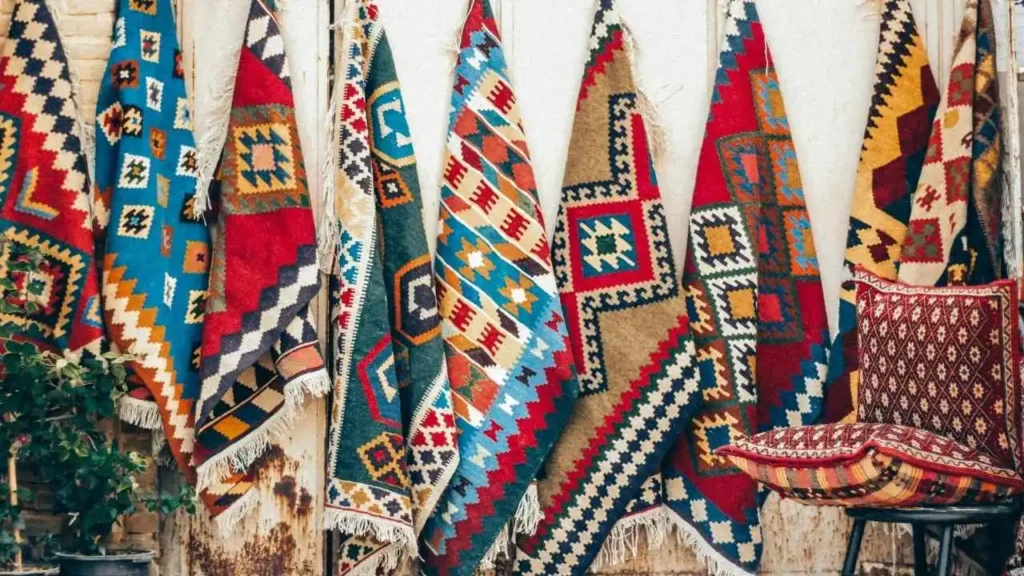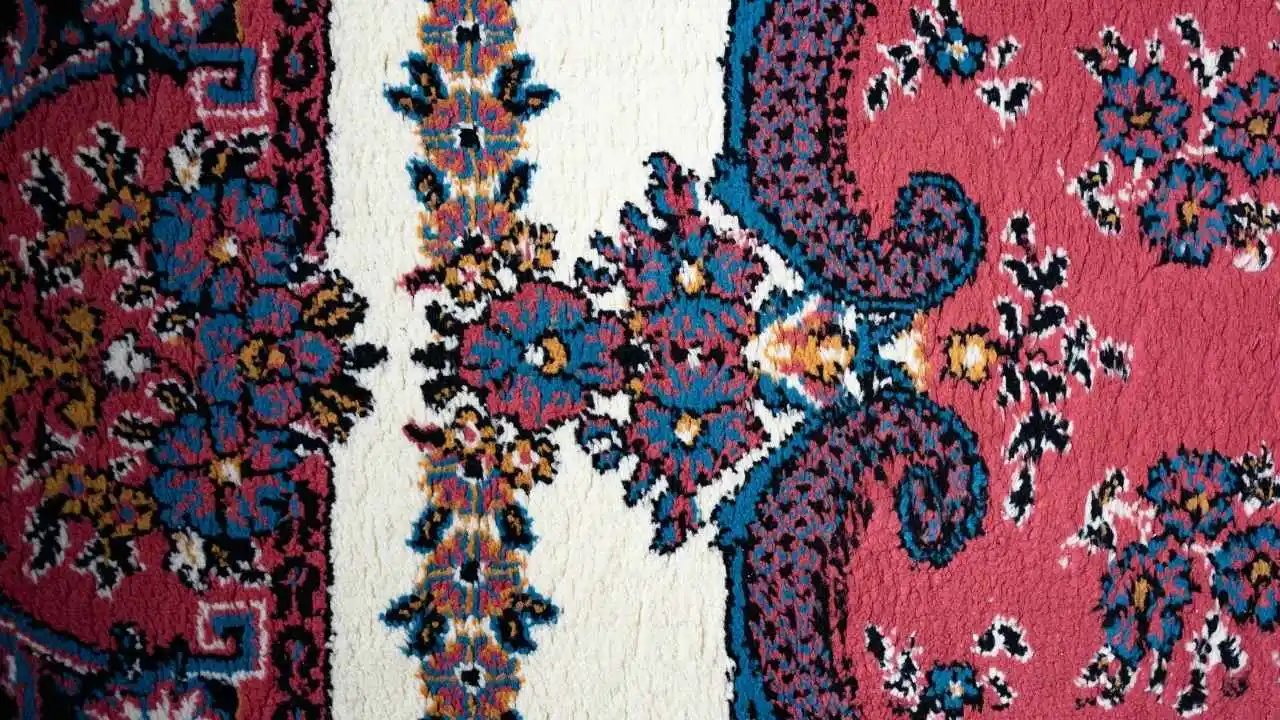Colors carry powerful symbolic meanings that can influence human behavior and emotions. In antique rugs, colors often reflect cultural symbols, traditions, and mythologies. In this article, we’ll explore how these meanings have shaped the design of Persian and Oriental carpets over time. We’ll also examine how specific color combinations were used to evoke certain moods or highlight particular features within a space. Our focus today is on red rug with blue star meaning —uncovering the deeper symbolism and artistic intention behind this striking design.

History of Persian Rugs
Persian rugs backdate over 2,500 years, narrating from ancient Persia. The design and weaving techniques of each dynasty evolved due to socio political climate and culture shifts during that time. In these historical contexts, the red rug with blue star meaning often symbolized a blend of cultural influences, with the red field representing vitality and the blue star denoting protection or guidance.
Walking on a Persian rug is like exploring a garden of history, showcasing the rise and fall of empires, love, loss, and longing. These rugs are crafted by ancient artisans, narrating the saga of Persia through their looms and threads.
The Loom of Legends
Persian rug’s uniqueness lies in its intricate intertwining of legends, myths, and cultures, making each rug a unique treasure with intricate designs reminiscent of a Persian epic poem.
Symbolism and Psychology of Colors
Colors significantly impact our moods, behaviors, and perceptions, influencing our feelings, thoughts, and perception of the world around us.
Generally speaking, chilly colors evoke negative feelings whereas warm hues evoke good ones. For instance, blue is cold and soothing, while red is warm and symbolizes love, passion, and desire. Orange is a warm and energizing color because it combines the colors red and yellow.
Color Meaning
Red— Love, energy, power, and passion; also stop sign, blood, and danger;masculine.
Orange— Energy, creativity, and stimulation.
Yellow— Sunshine, joy, and excitement; caution (slow down); fear or cowardice; jealousy or hate; caution (slow down); fear or cowardice.
Green— Progress, equilibrium, and relaxation; a safe haven;financial gain;peace and healing power.
Blue— Reliability, composure, character depth, devotion, and melancholy or depression.
Purple/Violet— Spirituality itself, spiritual force, royalty, wisdom, honor, and dignity.
Pink— The delicate, pleasant, and feminine aspects of friendship, love, and affection.

Symbolism of Colors Used in Antique Rugs
For many years, there has been debate concerning the color symbols employed in ancient rugs. The primary cause is that various cultures have represented their values and beliefs via the use of various colors. For instance, in Eastern culture, red is linked to love and happiness. Whereas in Western cultures, it is frequently associated with blood and passion. In one culture, the color green may represent justice or purity, yet in another, it may represent fertility or riches.
We’ll analyze some of the most popular shades found in antique oriental rugs as well as how various cultures have utilized them over time.

Green
One of the most prevalent hues on antique oriental rugs is green, which has been utilized for millennia by numerous nations world. The associations that each person has with colors also determine their significance. Yellow, for instance, might make some people feel happy while making others uneasy because it conjures up images of illness or bad luck. Where you live in the world can also affect the meaning of colors. For instance, in Europe pink is linked with femininity, whereas in Japan, it is associated with masculinity.
Knowing how each shade is interpreted is crucial in a society where colors are utilized to arouse feelings and create an emotional reaction.
Red
The importance of color in antique rugs was once highly prized. In many cultures, the color red represented riches and power. The phoenix, dragon, and mandarin chicken are the most commonly used symbols for the color red. Antique rug designs use all of these in one form or another. Red is frequently used as an accent color in oriental rugs to draw attention to particular elements of the pattern or design. Ted can be used as a border, around the edges, or even as a design element throughout antique rugs. In many civilizations, the color red represents wealth and good fortune. This could be the reason why so many individuals have used this color over the years in their interior design ideas.
Blue
Blue color represents equanimity and love. It also symbolizes integrity, knowledge and fidelity. Due to the way it complements the beauty of flowers, it is often used as a background color for floral fabric arrangements. Blue is the predominant colour of the Ardabil Carpet, one of the most famous carpets in the world. It is one of the oldest Persian carpets still being produced to this day, dating back to the 17th century. As blue also signifies love and loyalty, it’s a good wedding rug color or any rug for special occasions like birthdays and holidays, used in your home. Our blog is also related to red rug with blue star meaning. When selecting home décor, understanding the red rug with blue star meaning can add depth to your interior design, as it brings a piece of historical art into modern living spaces

Yellow
Yellow is associated with the sun, which nourishes all things here on Earth. Therefore, yellow is used to express happiness, abundance, pleasure and as a colour in premier rugs.You can easily get these good vibes in your home by incorporating red threads to weave in yellow-colored carpets. Yellow is also the color that brings intelligence and innovation. So a yellow-patterned carpet is especially suitable for students who need motivation to study or read at home.In older times, the hue was also linked to monarchy; because it was believed that only monarchs could afford to wear yellow. Consequently, yellow-damask carpets tended to be reserved for monarchs and other high nobility.You can use this color alone or in conjunction with other colors to influence how red or green (masculine or feminine) carpet will affect its environment.
Orange
Due to the fact that orange is the color of growth and fertility, it is widely used in traditional rugs. Orange is also the color of prosperity, abundance, and satisfaction. As red and other earth colors like brown or yellow are generally associated with wealth, orange is often combined with these colors. While designing, the antique carpet commonly uses one of its major colors and makes the carpet in some curvilinear patterns or floral patterns, including checkered or floral patterns with dots or stars around the margins.
Pink
Pink was often the dominant color in antique carpet designs and, as such, symbolized women’s power and all the aspects of female vigor. On different levels, the color pink also stood for a woman’s fertility and her role as a mother. Where religion is concerned, pink is more than a symbol of being feminine. In religion, specifically Muslim, this is a color of the sacred. It offers protection against spirits, demons, and evil eyes cursing those that would covet your riches and possessions.
Purple
Colors also play an important role in the patterning and design of ancient carpets. Purple is very commonly used to symbolize luxury, wealth, and greatness. Purple is also believed to possess healing powers. Centuries ago, purple was obtained by crushing sea snails to prepare a dye. This type of dye was accessible only to the rich upper class because it was quite expensive. Purple has only recently come to be associated with luxury and nobility. Because the act of wearing purple was believed to confer insight and power, purple is also associated with spirituality and mysticism. Handmade carpets or antique rugs are mostly made by skilled artists on looms. Though they may be made from various materials, including silk or wool threads, most antique rugs were made from wool fibers since they were more resistant to disintegration over time and more durable than silk threads.
Restoration and Maintenance of Colors in Antique Rugs
Additionally, colors may change, fade, or discolor in an antique rug. One of the most critical factors is exposure to light. There will be a fading on the rug depending on the amount of light it is exposed to. How much sun the rug receives depends on the placement and window presence or lack thereof. A rug kept away from areas around the vicinity of any windows would get less sunlight as opposed to one being nearby to all windows.
Yet another time when the colors seem faded is when someone tries to restore it and repaints over it. Such a project can fade them or make them darker in the process, depending upon what color paint was underneath originally. Here, it seems—as does the image—faded or washed out in comparison to what it was before restoration/new paint takeover. This is especially true when the new paint is a lighter version of black, red, orange, yellow, etc.
Notice, as you can, much of the restoration needed for the vintage rugs is color restoration and cleaning. This is precisely the case. People buy them for their resale value—but many are not taught how to maintain them properly. Yet maintenance and color preservation are possible. For example, do not soak your rug. Water will inevitably dissolve the natural fibers. Use something dry to clean your rug.
Secondly, when cleaning your rug, always use a soft brush or vacuum because these equipment won’t damage the fibers. Make sure the bristles on your vacuum are soft enough to avoid tearing or scratching your rug’s fibers if you do use one with brushes connected.
Conclusion
Finally, keep in mind that you may restore old rugs without lowering their investment value. Nevertheless, it could be preferable to leave an ancient rug alone if you are unsure about whether you should do it yourself or pay experts. Maintaining the colors of your antique rugs is as integral to the process as maintaining the fibers and backing. Antique rugs are more than just a pretty sight; the colors are integral details that keep the historical significance of the rug intact. By learning what the colors of your vintage area rug mean, you’ll be able to care for your vintage rug even better to keep its integrity intact, which, in the long run, helps preserve family history over generations. I hope you enjoyed our article red rug with blue star meaning.
FAQs
1. Why are most Persian rugs red?
Red is the color of wealth and good fortune.Persian carpets frequently include the color red, which represents courage, riches, and good fortune.
2. What is the psychology of rug color?
A rug color can immediately set the tone in a room for the space it occupies, affecting an individual’s mood and behavior. For example, a green rug in a home office can promote balance and focus, while a purple rug in a creative space can inspire imagination and depth of thought.
3. What does the oriental rug symbolize?
Oriental Turkish carpets normally have symbolic designs that are believed to possess special meanings or even powers. While some of the designs signify spiritual growth, enlightenment, and wisdom, others relate to fertility, abundance, and protection.
4. What does the peacock rug mean?
In addition to being aesthetically pleasing, the peacock design in carpets symbolizes monarchy, spirituality, and vigilance in many cultures.
5. What does the blue Persian rug mean?
Blue is a color which is associated with loyalty, honesty, duty, and trust. Having had a very rough past, it is one of the most frequent colors of Persian carpets, after red and beige. Few elements of blue color exist in nature that can be used as dyes.
